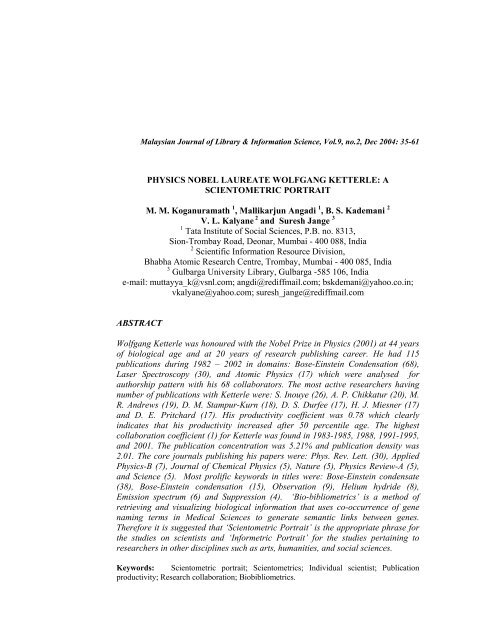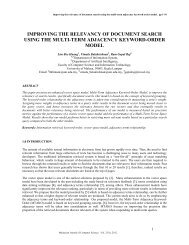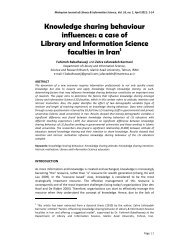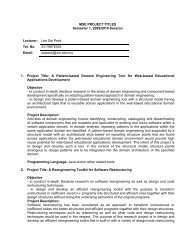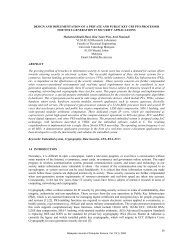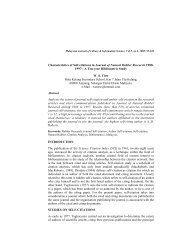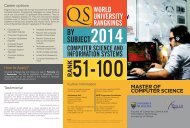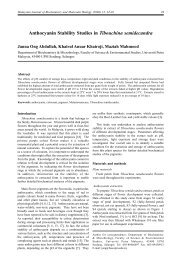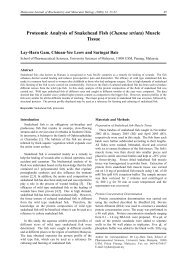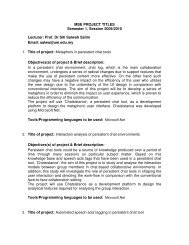PHYSICS NOBEL LAUREATE WOLFGANG KETTERLE: A ... - EJUM
PHYSICS NOBEL LAUREATE WOLFGANG KETTERLE: A ... - EJUM
PHYSICS NOBEL LAUREATE WOLFGANG KETTERLE: A ... - EJUM
Create successful ePaper yourself
Turn your PDF publications into a flip-book with our unique Google optimized e-Paper software.
Malaysian Journal of Library & Information Science, Vol.9, no.2, Dec 2004: 35-61<strong>PHYSICS</strong> <strong>NOBEL</strong> <strong>LAUREATE</strong> <strong>WOLFGANG</strong> <strong>KETTERLE</strong>: ASCIENTOMETRIC PORTRAITM. M. Koganuramath 1 , Mallikarjun Angadi 1 , B. S. Kademani 2V. L. Kalyane 2 and Suresh Jange 31 Tata Institute of Social Sciences, P.B. no. 8313,Sion-Trombay Road, Deonar, Mumbai - 400 088, India2 Scientific Information Resource Division,Bhabha Atomic Research Centre, Trombay, Mumbai - 400 085, India3 Gulbarga University Library, Gulbarga -585 106, Indiae-mail: muttayya_k@vsnl.com; angdi@rediffmail.com; bskdemani@yahoo.co.in;vkalyane@yahoo.com; suresh_jange@rediffmail.comABSTRACTWolfgang Ketterle was honoured with the Nobel Prize in Physics (2001) at 44 yearsof biological age and at 20 years of research publishing career. He had 115publications during 1982 – 2002 in domains: Bose-Einstein Condensation (68),Laser Spectroscopy (30), and Atomic Physics (17) which were analysed forauthorship pattern with his 68 collaborators. The most active researchers havingnumber of publications with Ketterle were: S. Inouye (26), A. P. Chikkatur (20), M.R. Andrews (19), D. M. Stampur-Kurn (18), D. S. Durfee (17), H. J. Miesner (17)and D. E. Pritchard (17). His productivity coefficient was 0.78 which clearlyindicates that his productivity increased after 50 percentile age. The highestcollaboration coefficient (1) for Ketterle was found in 1983-1985, 1988, 1991-1995,and 2001. The publication concentration was 5.21% and publication density was2.01. The core journals publishing his papers were: Phys. Rev. Lett. (30), AppliedPhysics-B (7), Journal of Chemical Physics (5), Nature (5), Physics Review-A (5),and Science (5). Most prolific keywords in titles were: Bose-Einstein condensate(38), Bose-Einstein condensation (15), Observation (9), Helium hydride (8),Emission spectrum (6) and Suppression (4). ‘Bio-bibliometrics’ is a method ofretrieving and visualizing biological information that uses co-occurrence of genenaming terms in Medical Sciences to generate semantic links between genes.Therefore it is suggested that ‘Scientometric Portrait’ is the appropriate phrase forthe studies on scientists and ‘Informetric Portrait’ for the studies pertaining toresearchers in other disciplines such as arts, humanities, and social sciences.Keywords: Scientometric portrait; Scientometrics; Individual scientist; Publicationproductivity; Research collaboration; Biobibliometrics.
Koganuramath M. M., Angadi, M., Kademani, B.S., Kalyane V. L., & Jange S.INTRODUCTIONBio-bibliometrics deals with the biographical study of the individual careers ofscientists and researchers and correlating bibliographic analysis of publications oracademic and scientific achievements.Some biographical and bio-bibliometric studies of individuals have been carried outoccasionally at the time of retirement or paying homage to an individual after death.For some noted individuals, their contributions are highlighted in the obituarycolumn of professional journals.Individuals are the source of ideas. The institutions are built by the individuals andgrow around individuals. Individuals are the basic foundations of any institution. Bystudying the individuals who have reached the top positions in academic andresearch life and by highlighting their works may stimulate the younger generationto emulate them.‘Bio-bibliometrics’ is a term that was first coined by Sen and Gan (1990) to mean asthe quantitative and analytical method for discovering and establishing functionalrelationships between bio-data and biblio-data elements. There are many biobibliometricstudies, but they have hardly used the term ‘bio-bibliometrics’ in thetitles of the papers except for Sen & Gan (1990) and Tiew (1999).Kalyane and Kalyane (1993) first used the phrase ‘Scientometric Portrait’ to carryout bio-bibliometric studies on scientists. In some of the papers Kalyane and Devarai(1994), Kalyane and Samanta (1995), and Devarai and Ramesh (1998) used the term‘Informetrics’ in the titles of their papers on C. S. Vekata Ram, K. Ramiah, and M.N. Srinivas respectively. However, there was a continuous use of the phrase‘Scientometric Portrait’ (Kademani et al., 1994; Kademani et al., 1994; Kalyane andKalyane, 1994; Kalyane and Kademani, 1995; Kalyane, 1995; Kalyane andMunnolli, 1995; Kademani, et al., 1996; Kademani et al., 1996; Kalyane and Sen,1996; Kademani and Kalyane, 1997; Kademani and Kalyane, 1998; Kalyane andSen, 1998; Kademani et al., 2000; Kademani, et al., 2001; Kalyane et al., 2001;Kalyane and Sen (website); Kamble, 2002; Kademani et al., 2002; Koganuramath, etal., 2003; Munnolli and Kalyane, 2003; Angadi et al., 2004) consistently.‘Information profile’ (Sinha and Bhatnagar, 1980; Sinha and Ullah, 1994) and‘citation profile’ phrase was used by S. C. Sinha and Ullah (1993). The phrase‘Bibliographics on publication productivity’ was used for the similar study (Kamble,36
Physics Nobel Laureate Wolfgang Ketterle2001). Subir K. Sen (1995), the Chairman of SIG - Informetrics, IASLICConference 1994, proposed the term ‘Microbibliometrics’ for the studies onindividual scientists, which were presented by V. L. Kalyane as ongoing projects onindividual scientists. The term ‘Information Career’ was used (Muddiman, 2003).Recently the term ‘Bio-bibliometrics’ is being used for method of retrieving andvisualizing biological information that uses co-occurrence of gene naming terms inMedical Sciences to generate semantic links between genes (Stapley and Benoit,n.d). Therefore, it is suggested that ‘Scientometric portrait’ is the appropriate phrasefor the studies on scientists, and ‘Informetric portrait’ for the studies on researchersin other disciplines such as arts, humanities, and social sciences.The Nobel Prize is regarded as the most honorific recognition of scientificachievement. The prestige of the Nobel prize is so great that it enhances thestanding of nations and institutions as well as the reputation of its “laureates”(Zuckerman, 1967; Zuckerman , 1967; Zuckerman , 1977).The Royal Swedish Academy of Sciences has awarded to Wolfgang Ketterle as oneof the three recipients of the Nobel Prize (2001) in Physics for the achievement ofBose-Einstein condensation in dilute gases of alkali atoms, and for earlyfundamental studies of the properties of the condensates. In addition to being amember of Research Laboratory of Electronics (RLE), Ketterle is an investigator inthe MIT-Harvard Centre for Ultracold Atoms (CUA). Ketterle's co-recipients of thePhysics Nobel Prize (2001) are Eric A. Cornell of (JILA) and the National Instituteof Standards and Technology, and Carl E. Wieman of JILA and the University ofColorado at Boulder.In 1924, the Indian physicist Satyendranath Bose made important theoreticalcalculations regarding light particles. He sent his results to Einstein who extendedthe theory to a certain type of atom. Einstein predicted that if a gas of such atomswere cooled to a very low temperature all of the atoms would suddenly gather in thelowest possible energy state. The process is similar to when drops of liquid areformed from a gas, hence the term condensation. Seventy-two years were to pass inachieving this extreme state of matter in 1995. Cornell and Wieman then produced apure condensate of about 2000 rubidium atoms at 20 nK (nanokelvin), i.e. 0.000 00002 degrees above absolute zero. Ketterle performed corresponding experiments withsodium atoms independently of the work of Cornell and Wieman. The condensateshe managed to produce contained more atoms and could therefore be used toinvestigate the phenomenon further. Using two separate Bose-Einstein Condensates37
Koganuramath M. M., Angadi, M., Kademani, B.S., Kalyane V. L., & Jange S.(BEC), which were allowed to expand into one another, he obtained very clearinterference patterns, i.e. the type of pattern that forms on the surface of water whentwo stones are thrown in at the same time. This experiment showed that thecondensate contained entirely co-ordinated atoms. Ketterle also produced a streamof small "BEC drops" which fell under the force of gravity. This can be consideredas a primitive "laser beam" using matter instead of light.Bose-Einstein Condensation was first achieved at 10:54 a.m. on June 5, 1995. BEChas been achieved in a variety of chemical elements. One of the latest developmentsis a BEC on a microelectronics chip. These achievements are a tribute to theingenuity and perseverance of experimenters and they demonstrate the suitableinterplay of many scientific techniques (Pandey, 2003).OBJECTIVESWolfgang Ketterle was taken as a case study for present scientometric analysis. Hisbiographical details and a brief resume can be found athttp://cua.mit.edu/ketterle_group/ketterle.htm and are well known.This study highlights Wolfgang Ketterle’s:• domainwise contributions,• domainwise authorships,• prominent collaborators,• use of channels of communications, and• documentation of keywords from titles of the papers.MATERIALS AND METHODSScientific publications seem to provide the best available basis for measuring theresearch output. One of the first writers to suggest scientific papers as a measure ofresearch productivity was Nobel laureate William Shockley (1957) who wasinterested in measuring the research productivity among individuals within a groupby analyzing their publications. A few scientometric studies on Nobel laureates(Cawkell and Garfield, 1980; Gupta, 1983; Kragh, 1990; Kademani et al., 1994;Kademani et al., 1996; Kalyane & Sen, 1996; Kalyane and Kademani, 1997;Kademani et al., 1999; Kademani et al., 2001; Kademani et al., 2002; Kademani etal., 2002; Koganuramath et al., 2003; Angadi et al., 2004) and others (Gupta, 1978;Ruff , 1979; Sinha and Bhatnagar, 1980; Gupta, 1983; Gupta, 1983; Dieks and38
Physics Nobel Laureate Wolfgang KetterleSlooten, 1986; Todorov and Winterhager, 1991; Lancaster et al., 1992; Lancaster etal., 1993; Seglen, 1993; Sinha and Ullah, 1993; Kademani et al., 1994; Kalyane andKalyane, 1994; Kalyane, 1995; Kalyane and Kademani, 1995; Kalyane andMunnolli, 1995; Kademani and Kalyane, 1996; Kademani and Kalyane, 1996;Kademani et al., 1996; Kalyane and Sen, 1998; Kademani and Kalyane, 1998;Brittain, 2000; Kademani et al., 2000; Kalyane et al., 2001; Rusthon, 2001; Sinha &Dhiman, 2001; Kalyane and Sen, 2002; Dave, 2003; Munnolli and Kalyane, 2003;Kalyane and Sen, 2003; Sen and Karanjia, 2003; Kalyane, 2004; Kalyane et al.,2004; Swarna et al., 2004a; Upadhye et al., 2004; Swarna et al., 2004b ) have beenpublished.The present study is limited to the 115 papers by Wolfgang Ketterle (1982-2002).The bibliographic fields were analysed by Normal Count Procedure (Kalyane andVidyasagar Rao, 1995) for domains, authorships, journals, and keywords in thetitles. The ratio of the number of multi-authored publications to the total number ofpublications in a defined period is called Collaboration Coefficient (Subramanyam ,1983).RESULTS AND DISCUSSIONDomainwise contributionsKetterle had research communications in the following domains:A = Laser Spectroscopy;B = Atomic Physics ; andC = Bose-Einstein Condensation.Ketterle had contributed 68 papers in the domain Bose - Einstein Condensation(1995 – 2002) followed by 30 papers in domain Laser Spectroscopy (1982 – 1999),and 17 papers in Atomic Physics (1983 – 2002). Domainwise profile of the annualgrowth of publications by Ketterle is presented in Figure 1.39
Koganuramath M. M., Angadi, M., Kademani, B.S., Kalyane V. L., & Jange S.Figure 1: Domainwise Publication Productivity of Wolfgang KetterleCollaboratorshipDomainwise authorship pattern and number of publications and authorships in eachdomain are presented in Table 1. Six authored Bose- Einstein Condensation paperswere 20, followed by one paper in Laser Spectroscopy. Two-authored Bose-Einstein Condensation papers were 14, followed by five papers in Atomic Physicsand three papers in Laser Spectroscopy. Seven-authored Bose-EinsteinCondensation papers were 12, followed by one paper in Laser Spectroscopy. ThreeauthoredBose-Einstein Condensation papers were 4, followed by four papers inAtomic Physics, and nine papers in Laser Spectroscopy. Five-authored Bose-Einstein Condensation papers were 4, followed by two papers each in AtomicPhysics, and Laser Spectroscopy. Eight-authored Bose - Einstein Condensationpapers were 2, followed by one paper in Laser Spectroscopy. Fourteen-authored onepaper was in Laser Spectroscopy, thirteen-authored one paper was in Bose-EinsteinCondensation, eleven authored one paper was in Bose-Einstein Condensation, tenauthoredone paper was in Laser Spectroscopy, and nine-authored one paper was inBose-Einstein Condensation.Wolfgang Ketterle had 18 single-authored papers in various domains such as Bose-Einstein Condensation (8), Atomic Physics (3), and Laser Spectroscopy (7). The40
Physics Nobel Laureate Wolfgang Ketterleyear-wise productivity of Wolfgang Ketterle is shown in Table 2 and Fig. 2. Hepublished his first paper in the year 1982. A total of 84.35 per cent of his paperswere collaborative.Table 1: Domainwise Productivity (1982 – 2002) of Number of Papers andAuthorship Pattern of the Nobel laureate Wolfgang KetterleNo. ofDomainsAuthoredpapers A B CTotalNo.ofpapersPercentageNo. ofAuthorshipsPercentage1-authored 7 3 8 18 15.65 18 03.732-authored 3 5 14 22 19.13 44 09.113-authored 9 4 4 17 14.78 51 10.564-authored 4 3 1 8 06.95 32 06.635-authored 2 2 4 8 06.95 40 08.286-authored 1 20 21 18.26 126 26.077-authored 1 12 13 11.30 91 18.848-authored 1 2 3 02.61 24 04.979-authored 1 1 00.87 09 01.8610-authored 1 1 00.87 10 02.0711-authored 1 1 00.87 11 02.2813-authored 1 1 00.87 13 02.6914-authored 1 1 00.87 14 02.09Total 30 17 68 115 100.00 483 100.00Percentage 26.09 14.78 59.13 100Authorships 3.70 2.76 4.72 4.2per paperA = Laser Spectroscopy;B = Atomic Physics;C = Bose-Einstein CondensationThe twentieth century has seen a tremendous collaborative research among scientistsworking in groups within and across the geographic boundaries of a country, whichenhanced the ability of scientists to put in their brain collectively and makesignificant progress in their respective domains of specialisation. Collaboration isinevitable to make significant advances and breakthroughs in natural sciences andmultidisciplinary areas. Whatever the advances have been made today are the resultsof endeavours of individual scientists as mentors (Marcina, 2000; Sindermann,1985; Long and McGinnis, 1985).41
Koganuramath M. M., Angadi, M., Kademani, B.S., Kalyane V. L., & Jange S.Age ofWolfgangKetterleTable 2: Collaboration Pattern of Wolfgang KetterleYear Number of papers under various authorships CollaborationSingle Multi-authored Total Coefficientauthored25 1982 1 - 1 0 126 1983 - 1 1 1 227 1984 - 1 1 1 328 1985 - 1 1 1 429 1986 1 1 2 0.5 531 1988 - 4 4 1 732 1989 2 6 8 0.75 833 1990 4 5 9 0.56 934 1991 - 2 2 1 1035 1992 - 7 7 1 1136 1993 - 3 3 1 1237 1994 - 1 1 1 1338 1995 - 3 3 1 1439 1996 1 10 11 0.91 1540 1997 1 6 7 0.86 1641 1998 1 12 13 0.92 1742 1999 2 11 13 0.85 1843 2000 4 5 9 0.56 1944 2001 - 11 11 1 2045 2002 1 7 8 0.88 21Total 18 97 115% 15.7 84.3 100The highest collaboration coefficient (1.00) for Wolfgang Ketterle was found in1983-1985, 1988, 1991-1995, and 2001.The Productivity Coefficient (Sen and Gan, 1990) is the Ratio of the productivityage (corresponding to the 50 percentile productivity) to the total productivity life.Productivity Coefficient for Wolfgang Ketterle was 0.78, which is a clear indicationthat his productivity increased after 50-percentile age. His total productivity agestudied here spans 16 years (1982-2002) during which he produced 115 scientificpublications. Fifty percent of his total publications were produced within five years(1998-2002). He had the highest number of collaborative papers (12) in 1998 andpublished the highest (13) number of papers in 1998 and 1999. He published elevenpapers in 1996 and 2001 respectively. He did not publish a single paper in the year1997.PublishingCareer Age42
Physics Nobel Laureate Wolfgang KetterleFigure 2: Growth Pattern of Single-Authored and Multi-Authored Paper ofWolfgang KetterleThe researchers and their authorships in collaboration with Wolfgang Ketterle in thechronological order of their association (starting with the first paper publicationyear) are documented in Table 3 and depicted in Figure 3.Collaborator dynamicsIn the first quinquennium (QI) there were 6 collaborators, followed by in QII (26),QIII (20) and QIV (28). Overlap or continuity of the collaborators (bold numbers)between two quinquenniums and new collaborators between two quinquenniums(normal figures) are indicated in Table 4. For example, out of 6 collaborators in theQI four continued to collaborate in QII also, while 22 new collaborators joinedduring QII thus making a cohort of 26 collaborators in QII.Domainwise authorshipsTable 5 shows author productivity and distribution of authors in various domains.The research group of Wolfgang Ketterle had the credits as number of authorships invarious domains: Bose-Einstein Condensation (326), Laser Spectroscopy (112), andAtomic Physics (45).43
Koganuramath M. M., Angadi, M., Kademani, B.S., Kalyane V. L., & Jange S.Table 3: Domainwise and Chronological profile (1982 – 2002) of the Nobel laureateWolfgang KetterleSl.No.ResearcherDomainsPeriod ofCollaborationFPY-LPYTYNo. ofAuthorshipsA B C1. Ketterle, W. 30 17 68 1982-2002 21 1152. Gotze, W. 1 1983-1983 1 13. Fukuda, Y. 1 1984-1984 1 14. Figger, H. 5 1984-1989 6 55. Walther, H. 10 2 1984-1989 6 126. Dodhy, A. 2 1 1986-1988 3 37. GraBhoff 1 1988-1988 1 18. Messmer, H.P. 1 2 1988-1989 2 39. Kollner, M. 2 1989-1990 2 210. Suntz, R. 2 1989-1990 2 211. Becker, H. 4 1989-1991 3 412. Monkhouse, P. 3 1989-1992 4 313. Arnold, A. 10 1989-1994 6 1014. Wolfrum, J. 11 1989-1994 6 1115. Behrendt, F. 1 1990-1990 1 116. DieBel, E. 1 1990-1990 1 117. Dreier, T. 1 1990-1990 1 118. Hemberger, R. 2 1990-1990 1 219. Hentschel, W. 1 1990-1990 1 120. Herden, R. 1 1990-1990 1 121. Meienburg, W. 1 1990-1990 1 122. Neckel, H. 1 1990-1990 1 123. Schindler, K. P. 1 1990-1990 1 124. Sick, V. 2 1990-1990 1 225. Thiele, K. U. 1 1990-1990 1 126. Warnatz, J. 1 1990-1990 1 127. Lange, B. 2 1990-1992 3 228. Schafer, M. 6 1990-1992 3 629. Bouche 1 1992-1992 1 130. Dinkelacker, F. 1 1992-1992 1 131. Heitzmann, T. 1 1992-1992 1 132. Kohler, J. 1 1992-1992 1 133. Schiff, G. 1 1992-1992 1 134. Stolz, W. 1 1992-1992 1 1QuinquenniumQIQII44
Physics Nobel Laureate Wolfgang Ketterle35. Martin, A. 3 1992-1993 2 336. Joffe, M. A. 4 1992-1995 4 437. Pritchard, D. E. 2 5 10 1992-2002 11 1738. Davis, K. B. 3 2 1993-1996 4 5 QIII39. Druten, N.J van 1 9 1995-1997 2 1040. Mewes, M. O. 2 10 1995-1997 3 1241. Kurn, D. M. 12 1995-1998 4 1242. Andrews, M. R. 1 18 1995-1999 5 1943. Durfee, D. S. 17 1995-2000 6 1744. Townsend, C.G 7 1996-1997 2 745. Stringari, S. 1 1997-1997 1 146. Miesner, H. J. 17 1997-1999 3 1747. Inouye, S. 26 1997-2001 5 2648. Stenger, J. 12 1998-2000 3 1249. StamperKurn,D 18 1998-2001 4 1850. Chikkatur, A. P. 1 19 1998-2002 5 2051. Kohl, M. 2 1999-2000 2 252. Kuklewicz,C.E 2 1999-2000 2 253. Pfau, T. 2 1999-2000 2 2QIV54. Onofrio, R. 4 1999-2001 3 455. Gorlitz, A. 1 9 1999-2002 4 1056. Gupta, S. 10 1999-2002 4 1057. Hadzibabic, Z. 2 1999-2002 4 258. Raman, C. 12 1999-2002 4 1259. Low, R. 1 2000-2000 1 160. Abo-Shaeer, JR 8 2000-2002 3 861. Gustavson,T.L. 5 2000-2002 3 562. Vogels, J. M. 1 7 2000-2002 3 863. Rosenband, T. 3 2001-2001 1 364. Leanhardt, A.E. 4 2001-2002 2 465. Xu, K. 4 2001-2002 2 466. Anglin, J. R. 2 2002-2002 1 2 QV67. Dieckmann, K. 1 2002-2002 1 168. Stan, C. A. 1 2002-2002 1 169. Zwierlein,M.W. 1 2002-2002 1 11- Total 112 45 326 1982-2002 21 48369(A = Laser Spectroscopy; B = Atomic Physics ; C = Bose-Einstein Condensation; FPY =First Publication Year; LPY = Last Publication Year; TY = Total years)45
Koganuramath M. M., Angadi, M., Kademani, B.S., Kalyane V. L., & Jange S.Figure 3: Authorship Credits to Collaborators with Wolfgang KetterleTable 4: Cohort of Collaborators in the Quinquennium, Number of CommonCollaborators and New collaborators between the Respective QuinquenniumsQIQI(1982 – 1986)(6)QIIQII(1987 – 1991)4(26)22(26)QIIIQIIIQIV(1992 – 1996) (1997 – 2001)KK(20)(28)19274K(20)(29)16287(20)(27)20QIV (28)(Tuple: Collaborators during the quinquennial period in (italics bold) parenthesis; bold atopcorner for number of common collaborators ; normal bottom corner for number of newcollaborators ; and K for Ketterle alone common between the quinquenniums )46
Physics Nobel Laureate Wolfgang KetterleNo. ofPapers(p)Table 5: Publication Productivity (1982-2002) of Wolfgang Ketterle and hisCollaboratorsDomainsA B CNo. ofAuthors(n)TotalAuthorships(nxp)Prominent Collaborators1 18 1 5 24 242 10 10 10 203 6 6 3 5 154 4 4 12 5 205 5 3 7 3 156 6 1 6 Schafer, M.7 7 1 7 Townsend, C.G.8 1 15 2 16 Abo-Shaeer, J.R. and Vogels, J. M.10 10 2 28 4 40 Arnold, A; Druten, N.J; Gorlitz, A.and Gupta, S.11 11 1 11 Wolfrum, J.12 10 4 46 5 60 Walther, H. ; Mewes, M.O. ;Kurn, D.M. ; Stenger, J. andRaman, C.17 2 5 44 3 51 Pritchard , D.E. ; Durfee, D.S. andMiesner, H.J.18 18 1 18 Stampur-Kurn, D.M.19 1 18 1 19 Andrews, M.R.20 1 19 1 20 Chikkatur, A.P.26 26 1 26 Inouye, S.115 30 17 68 1 115 Ketterle, W.Total 112 45 326 69 483(A = Laser Spectroscopy; B = Atomic Physics ; C = Bose-Einstein Condensation)Prominent CollaboratorsMost active researchers with number of publications with Wolfgang Ketterle (Table5) were : S. Inouye (26), A. P. Chikkatur (20), M. R. Andrews (19), D. M. Stampurkurn(18), D. S. Durfee (17), H. J. Miesner (17), D. E. Pritchard (17), H. Walther(12), M. O. Mewes (12), D. M. Kurn (12), C. Raman (12), J. Stenger (12), J.Wolfrum (11), A. Arnold (10), N. J. Druten (10), A. Gorlitz (10), and S. Gupta (10).Five scientists had collaboration in three papers each. Ten scientists hadcollaboration in two papers each. Twenty-four scientists could only collaborate inone paper each. The total number of authors in the research group was 69 and totalnumber of authorships was 483.47
Koganuramath M. M., Angadi, M., Kademani, B.S., Kalyane V. L., & Jange S.Use of channels of communicationsDistribution of Wolfgang Ketterle’s 115 publications were spread over 24 journals,19 conference proceedings, books, etc. Channelwise scattering of publications ofWolfgang Ketterle is provided in Table 6 and Fig. 4 He has published 30 papers inPhys. Rev. Lett. (1985-2002), 7 papers in Applied Physics-B (1990-1995), 5 paperseach in Journal of Chemical Physics (1988-1990), Nature (1998-2002), PhysicalReview-A (1989-2001), and Science (1996-2001). Figure 5 indicates the growth ofpublications by Wolfgang Ketterle in the 6 core journals. The publicationconcentration was 5.21 % and the publication density was 2.01Table 6: Dissemination Channels of Publications used by Wolfgang KetterleSl. Channel of Communication No. of Cumu- FPY - LPY TY IFNo.Papers lative1. Phys. Rev. Lett. 30 30 1985 - 2002 18 6.4622. Appl. Phys. B 7 37 1990 - 1999 10 1.9133. J. Chem. Phys. 5 42 1988 - 1990 3 3.3014. Nature 5 47 1998 - 2002 5 25.8145. Phys. Rev. A 5 52 1989 - 2001 12 2.8316. Science 5 57 1996 - 2001 6 23.8717. Chem. Phys. Lett. 4 61 1986 - 1989 4 2.3648. Z. Phys. D 3 64 1988 - 1989 2 -9. J. Low Temp. Phys. 2 66 1998 - 2001 4 1.05810. Optics & Photonics News 2 68 1998 - 1999 2 -11. Phys. Bull. 2 70 1996 - 1997 2 -12. Appl. Opt. 1 71 1990 - 1990 1 1.91313. Ber. Bunsenges. Phys. Chem. 1 72 1992 - 1992 1 1.53114. Can. J. Phys. 1 73 1984 - 1984 1 0.55115. Europhys. Lett. 1 74 1989 - 1989 1 2.22816. Experiments in Fluids 1 75 1992 - 1992 1 0.70217. J. Opt. Soc. Am. B 1 76 1993 - 1993 1 1.94318. Physics Today Japanese (Parity) 1 77 2000 - 2000 1 -19. LEOS Newsletter 1 78 1996 - 1996 1 -20. Optics Express 1 79 1998 - 1998 1 1.81121. Physica 1 80 2000 - 2000 1 -22. Physics World 1 81 1997 - 1997 1 1.28123. Physique Astrophysique 1 82 2001 - 2001 1 -24. Z. Phys. B 1 83 1983 - 1983 1 -25-57. Others in Books, Conf. etc. 32 115(FPY = First Paper Year, LPY = Last Paper Year, and TY = Total Years, IF = Impact Factortaken from Journal Citation Reports - 2001)48
Physics Nobel Laureate Wolfgang KetterleFigure 4: Bradford – Zipf Bibliograph for Wolfgang KetterleFigure 5: Growth of the Publications by Wolfgang Ketterle Preferentially Contributeto Six Journals49
Koganuramath M. M., Angadi, M., Kademani, B.S., Kalyane V. L., & Jange S.Distribution of Wolfgang Ketterle’s publications in different types ofcommunication channelsIt is clearly evident from Table 7 that his 72.15 percentage of publications werepublished in scientific journals followed by (16.5%) publications in conferenceproceedings.Table 7: Distribution of Wolfgang Ketterle’s Publications in Different Types ofCommunication ChannelsSl.No. Document Type No of Papers1. Journal Articles 832. Conf/Sem. Papers 193. Edited books 44. Pre-Print 35. Dissertation 26. Books 17. Encyclopaedia 18. Patent 19. Year Book 1Total 115Keyword TomographyThe recent study on Database Tomography (Kostoff and Eberhart, 1997) forResearch Impact Assessment is interesting. Titles of publications convey preciselythe thought contents of the papers. The potency of information concentrated on thetitles of the papers is more than the rest of the sections of the papers. Therefore if aword occurs more frequently than expected it to occur, then it reflects the emphasisgiven by the author about the domain of his research. These important words called‘keywords’ are one of the best indicators to understand and to grasp instantaneouslythe thought content of the papers, methodologies used and areas of researchaddressed to. The keyword frequencies appeared in the titles of the papers isprovided in Tables 8 – 9. High frequency keywords were Bose-Einstein condensate,Bose-Einstein condensation, Observation, Helium hydride, Emission spectrum,Suppression.50
Koganuramath M. M., Angadi, M., Kademani, B.S., Kalyane V. L., & Jange S.Table 9: Keywords Appeared Only Once in the Titles of the Papers (1982 – 2002)by Wolfgang Ketterle2D determination; 2D single-shot imaging;2D-LIF of OH; Absolute temperature fields; Absolutennullpunkt; Amplification; Analytical model; Atmospheric pressure flames; Atom cooling; Atom traps;Atomic beam; Atomic matter waves;Atomic physics; Atoms; Atoms optics; Autoionizing rydbergstates of H3; Bending vibration; Boes-Einstein condensate; Boes-Einstein condensates; Bogoliubovtransformation; Bose and Fermi gases; Bose condensate;Bose-Einstein condensed atoms; Boseeinsteinkondensation; Bose-Einstein-kondensate; Bose-Einstein-kondensation; Bosonic stimulation;Bound helium hydride; Bound-free emission ; CARS spectroscopy; CH3OH/O2-mixtures; Coherenceproperties ; Cold atoms; Collective excitations; Collisionless ; Collisions at nanokelvin temperatures;Combustion processes; Condensed matter physics; Confining dc magnetic trap; Correlated atomicbeams; Counterflow diffusion flames; Critical velocity; Dark light traps; Dark spontaneous-force;Deflection; Degenerate; Determination; Discrete spectrum; Disordered conductors; Dissipationlessflow; Effective collisional lifetimes; Electronic structure; Evaporative; Evidence; Excimer lasers;Excitation; Fehbach resonances; Fermions; Feshbach resonances; Finite number; Finite temperatures;Flames; Focusing ground state atoms; Formation; Formation and decay; Four-wave mixingcondensates; Gas of sodium atoms; Gas von natrium-atomen; Gaseous; Gravitational limitations;Ground state; Helium hydride molecule; High densities; High rydberg states; Higher densities of coldatoms; Highly anisotropic traps; Hydrodynamic excitations; I bands near 5600, 5800 and 6025 A; Ibands near 8000 A; Ideal bose gas; Ignition processes; II bands near 4500 and 7100 A; II bands near5500 and 6400 A; III bands near 5200; 5300 and 6000 A; Impurity scattering; Inelastic collisions;Intense slow atom beams; Intensity graded light sheet; Interference; Isotropic laser light; IV bandsnear 4100 and 4600 A; Laser in-situ monitoring; Laser stimulation; Lifetimes of triatomic hydrogenmolecules; Light; Low-lying Rydberg states(n = 2 - 5); Lower dimensions; Magnetic trap; Making;Matter; Metastable state; Mgnetically trapped nanokelvin atoms; Modeling; N=3 states of H3; ND4schuler band; Neon hydride; Neue form von quantenmaterie; Neutralized ion beam experiment; Newform; Non-destructive imaging; Nuclear spin relaxation; OH radicals; One or three dimensions;Optical bragg scattering; Optical tweezers; Optically confined; Output coupler; Particales trapped;Phase-coherent amplification; Phonons; Potical trap; Promising technique; Propagation of sound;PTA; Quantum degeneracy; Quantenmechanik; Quantum; Quantum tunneling; Reversible formation;Saturated 2D-LIF of OH; Simultaneous; Single-shot imaging of OH and O2; Slowing; Sodium;Sodium atoms; Spectra; Spinor condensates; Spontaneous emission; Static field; Stirred; Strongly;enhanced; Superfluid flow; Superfluidity; Surface excitations; Third velocity component; Timedependentpotentials; Traiatomic hydrogen; Transport; Transverse cooling; Trapping; Tratomichydrogen; Triatomic hydrogen; Tunable KrF excimer laser; Two bose condensates; Two speciesmixture; Two-diamensinal laser induced fluorescence; Two-dimensional laser diagnostics; Two-stepcondensation; Two-wavelength excimer laser ;Two-wavelength operation; Ultracold atomic gases;Understanding; V characterization; V1 vibration of H3+; Vortex excitations; Vortex lattices; Vortexnucleation; Vortex phase singularities; Wave amplification; Weakly interacting gas; Zeeman slower;Zero Kelvin Rydberg spectrum of H352
Physics Nobel Laureate Wolfgang KetterleCONCLUSIONWolfgang Ketterle’s publication productivity under study for 21 years (1982 –2002) during which he has published 115 papers indicated that his productivityincreased after his 50 percentile age i.e. from 1998 onwards. The percentage ofcollaborative work of the scientist was found to be very high as he had as many as68 collaborators whom he guided as mentor. The scientist worked in highlyspecialsed fields. His papers have been scattered in 24 scientific journals. Hereceived many awards and honours including the Nobel Prize in physics in 2001.This kind of quantitative studies with graphic presentations facilitate one to studyand grasp with clear perceptions about the work of a scientist. It will be aninteresting study if one attempts to study the analysis of citations, socio-culturalbackgrounds of Nobel laureates and incorporate their personal views on variousaspects which would enhance the quality of the study. The biobibliometrics term isused for a method of retrieving and visualizing biological information that uses cooccurrenceof gene naming terms in Medical Sciences to generate semantic linksbetween genes (Stapley and Benoit, n.d). Therefore it is suggested that‘Scientometric Portrait’ is the appropriate phrase for the studies on scientists and‘Informetric Portrait’ for the researchers in other disciplines such as arts, humanities,and social sciences.REFERENCESAngadi, Mallikarjun, Koganuramath, M. M., Kademani, B. S., Kalyane, V. L., andSen, B. K. 2004. Scientometric Portrait of Nobel laureate Leland H. Hartwell.WIS-2004, International Workshop on Webometrics, Informetrics andScientometrics, (eds.) Hildrun Kretschmer, Yogendra Singh, and RameshKundra, (2-5 March, 2004), Organised by Society for Information Science, NewDelhi, and Indian Institute of Technology, Roorkee, India,: 10-30. Available at:http://eprints.rclis.org/archive/00001442/Brittain, J. M. 2000. A highly visible scientist – Jack Meadows. Journal ofInformation Science, Vol. 26, no. 4: 267 – 27.Cawkell, T., and Garfield, E. 1980. Assessing Einstein’s impact on today’s sciencebycitation analysis. In: Einstein: The first hundred years, ed. by M. Goldsmith etal., Pergamon, Oxford : 31 – 40.53
Koganuramath M. M., Angadi, M., Kademani, B.S., Kalyane V. L., & Jange S.Devarai, R. S.,and Ramesh, L. S. R. C. V. 1998. Informetrics on M. N. Srinivas.Annals of Library Science and Documentation, Vol. 45, no. 4: 125-135.Dieks, D.,and Slooten, W. J. 1986. Historic papers in physics: The case of HugoMartin Tetrode, 1895 – 1931. Czechoslovak Journal of Physics-B, Vol. 36:39 – 42.Gupta, D. K. 1978. Plate Tectonics: A study of transmission of ideas. Annals ofLibrary Science and Documentation, Vol. 25, no. 1- 4: 86-92.Gupta, D. K. 1983. Chandrasekhar, winner of the 1983 Nobel prize for Physics: Acitatioion analysis study of his works. Annals of Library Science andDocumentation, Vol. 30, no. 3-4: 177-184.Gupta, D. K. 1983. Citation analysis: A case study of a most cited author and hismost cited article on sea – floor spreading. IASLIC Bulletin, Vol. 28, no. 1: 1 –12.Gupta, D.K.,and Gupta, S. A. 1983. Citography on LePichon’s article on sea – floorspreading and continental drift: Application of Bradford’s Law. IASLIC Bulletin,Vol. 28, no.2: 49 – 58.Kademani, B. S.,Kalyane, V. L. and Kademani, A. B. 1994. Scientometric portraitof Nobel laureate Dr. C. V. Raman, Indian Journal of Information, Library andSociety Vol. 7, no. 3-4: 215 – 249. Available at: http://eprints.rclis.org/archive/ 00001377/Kademani, B. S.,Kalyane, V.L.and Balakrishnan, M. R. 1994. Scientometric portraitof P. K. Iyengar. Library Science with a slant to Documentation andInformation Studies, Vol. 31, no. 4: 155 – 176. Available at:http://eprints.rclis.org/archive/00001283/Kademani, B.S. and Kalyane, V.L. 1996. Bibliometric indicators of publicationproductivity analysis of an individual scientist. JISSI: The International Journalof Scientometrics and Informetrics, Vol. 2, no. 4: 49 -58. Available at:http://eprints.rclis.org/archive/00001246/Kademani, B.S. and Kalyane, V.L. 1996. Outstandingly cited and most significantpublications of R. Chidambaram, a nuclear physicist. Malaysian Journal of54
Physics Nobel Laureate Wolfgang KetterleLibrary and Information Science, Vol. 1, no.1: 21 – 36. Available at:http://eprints.rclis.org/archive/00001277/Kademani, B.S., Kalyane, V. L. and Kademani, A.B. 1996. Scientometric portraitof Sir K. S. Krishnan. Indian Journal of Information, Library and Society,Vol.9, no. 1 – 2: 125- 150. Available at: http://eprints.rclis.org/archive/00001313/Kademani, B. S., Kalyane, V. L.and Kademani, A. B. 1996. Scientometric portraitof Nobel laureate S. Chandrasekhar. JISSI: The International Journal ofScientometrics and Informetrics, Vol. 2, no.2-3: 119 –135. Available at:http://eprints.rclis.org/archive/00001516/Kademani, B.S.and Kalyane, V. L. 1998. Scientometric portrait of R.Chidambaram, the Indian Nuclear Physicist: A citation analysis. KELPROBulletin, Vol. 2, no.1: 13–29. Available at:http://eprints.rclis.org/archive/00001242/Kademani, B. S., Kalyane, V. L. and Jange, S. 1999. Scientometric portrait ofNobel laureate Dorothy Crowfoot Hodgkin. Scientometrics, Vol. 45, no. 2: 233-250. Available at: http://eprints.rclis.org/archive/00001519/Kademani, B. S., Kalyane, V. L. and Vijai Kumar. 2000. Scientometric portrait ofVikram Ambalal Sarabhai : A citation analysis. SRELS Journal of InformationManagement, Vol. 37, no. 2: 107-132. Available at:http://eprints.rclis.org/archive/00001237/Kademani, B.S.,Kalyane, V. L. and Vijai Kumar. 2001. Scientometric portrait ofNobel laureate Ahmed Hassan Zewail. Malaysian Journal of Library andInformation Science, Vol. 6, no. 2: 53-70. Available at: http://eprints.rclis.org/archive/00001515/Kademani, B. S., Kalyane, V. L. and Vijai Kumar. 2002. A.H. Zewail : Researchcollaborator par excellence. Scientometrics, Vol. 53, no. 1: 113 –121. Availableat: http://eprints.rclis.org/archive/00001505/Kademani, B. S., Kalyane, V. L. and Vijai Kumar. 2002. Scientometric portrait ofNobel laureate Harold W. Kroto. SRELS Journal of Information Management,Vol.39, no. 4: 409 – 434. Available at: http://eprints.rclis.org /archive/00001391/55
Koganuramath M. M., Angadi, M., Kademani, B.S., Kalyane V. L., & Jange S.Kalyane, V. L. 2004. Scientometric Portrait of L. L. Narayana, In: KnowledgeSocieties and Libraries: Papers in Honour of Prof. A.A.N. Raju, ed. by LaxmanRao, N, Sudarshan Rao, S. and Prafulla Chandra, T. V., Ess Ess Publishers, NewDelhi: 362-388. (ISBN: 81-7000-353-9). Available at:http://eprints.rclis.org/archive/00002264/Kalyane, V. L. 1995. Scientometric portrait of P. M. Bhargava. LucknowLibrarian, Vol. 27, no. 1-4: 42-70. Available at: http://eprints.rclis.org/archive/00001398/Kalyane V. L., Anil Sagar, Anil Kumar, Vijai Kumar, Lalit Mohan and Praksan, E.R. 2004. Library and Information Profession in India: Reflections andRedemptions, In: Dr. P.S.G. Kumar Festschrift, Library and InformationProfession in India: eflections and Redemptions. Vol. 1, Part-I, ed. byVashishth, C. P. and M. P. Satija; Executive Editors: M. R. Kherde and P. B.Jain. Delhi:B.R. Publishing Corporation, 144-159. (ISBN 81-7646-466-X).Available at: http://eprints.rclis.org/archive/00001039/Kalyane,V.L. and Devarai, R.S. 1994. Informetrics on C. S. Venkata Ram. In : NewHorizons in Library and Information Science ,ed. by C. P. Vashisth, L. S.Ramaiah, N. V. Jagga Rao and T. V. Prafulla Chandra, Madras: T. R.Publications: 475 – 478.Kalyane,V.L. and Kademani, B.S. 1995. Scientometric portrait of R.Chidambaram: A publication productivity analysis. Journal of InformationSciences, Vol. 5, no. 3: 101-140. Available at: http://eprints.rclis.org/archive/00001332/Kalyane,V.L. and Kademani, B. S. 1997. Scientometric portrait of BarbaraMcClintock: The Nobel laureate in physiology. KELPRO Bulletin, Vol. 1, no.1:3 – 14. Available at: http://eprints.rclis.org/archive/00001247/Kalyane, V. L. and Kalyane, S. V. 1993. Scientometric portrait of Vinodini Reddy.Journal of Information Sciences, Vol. 4, no.1: 25-45. Available at:http://eprints.rclis.org/archive/00001304/Kalyane, V.L. and Kalyane, S. V. 1994. Scientometric portrait of M.S.Swaminathan. Library Science with a slant to Documentation and Information56
Physics Nobel Laureate Wolfgang KetterleStudies, Vol. 31, no.1: 31-46. Available at: http://eprints.rclis.org/archive/00001288/Kalyane, V. L. and Munnolli, S. S. 1995. Scientometric portrait of T.S. West.Scientometrics, Vol. 33, no. 2: 233-256. Available at: http://eprints.rclis.org/archive/00001402/Kalyane, V. L., Prakasan, E. R. and Vijai Kumar. 2001. Scientometric portrait ofRanjit Kumar Mitra. ILA Bulletin, Vol. 37, no. 2: 39-53. Available at:http://eprints.rclis.org/archive/00001067/Kalyane, V. L. and Samanta, R. K. 1995. Informetrics on K. Ramiah. In : NewVistas in Library and Information Science, ed. by A. A. N. Raju et al., Delhi :Vikas. pp. 565-578. Available at: http://eprints.rclis.org/archive/00001278/Kalyane, V. L. and Sen, B. K. 1996. Scientometric portrait of Nobel laureatePierre – Gilles de Gennes. Malaysian Journal of Library & InformationScience, Vol. 1, no. 2: 13-26. Available at: http://eprints.rclis.org/archive/00001065/Kalyane, V. L. and Sen, B. K. 1998. Scientometric portrait of C. R. Bhatia, ageneticist and plant breeder. Malaysian Journal of Library and InformationScience, Vol. 3, no. 1: 25-42. Available at: http://eprints.rclis.org/archive/00001239/Kalyane, V. L. and Sen, B. K. 2002. Scientometric Portrait of Tibor Braun.Available at: http://tibor-braun.fw.hu 1- 13.Kalyane, V. L. and Sen, B. K. 2003. Research productivity of Tibor Braun : Ananalytical chemist – cum scientometrician. Annals of Library and InformationStudies, Vol. 50, no. 2: 47-61. Available at: http://eprints.rclis.org/archive/00001374/Kalyane, V. L. and Vidyasagar Rao, K. 1995. Quantification of credits forauthorship. ILA Bulletin, Vol. 30, no.3-4: 94-96. Available at:http://eprints.rclis.org/archive/00001280/57
Koganuramath M. M., Angadi, M., Kademani, B.S., Kalyane V. L., & Jange S.Kamble, Pradeep S. 2001. Bibliographics on publication productivity of J. V.Narlikar and his collaborators. Available at: http://eprints.rclis.org/archive/00001349/Kamble, Pradeep S. 2002. Scientometric Portrait of Jayant Vishnu Narlikar.Dissertation submitted as a partial fulfilment for the degree of M. L. I Sc.,(Sharadchandra Pawar College of Library & Information Science affiliated totheDr. Babasaheb Ambedkar Marathwada University, Aurangabad), 292 pages.Koganuramath, M. M., Angadi, Mallikarjun, Kademani, B. S., Kalyane, V. L. andJange, Suresh. 2003. Scientometric portrait of Nobel Laureate WolfgangKetterle. Knowledge Management in Special Libraries in Digital Evironment,XXIV All India Conference of IASLIC, Dehra Dun, 15-18 December, 2003.SIG: Informetrics, Theme: Biobiblimetrics ; Special publication 43, Abstract ;447. Available at: http://eprints.rclis.org/archive/00001058/Kostoff, R. N., Eberhart, H. J., Toothman, D. R., Pellenbarg, R. 1997. Databasetomography for technical intelligence: Comparative roadmaps of the researchimpact assessment literature and the Journal of the American Chemical Society.Scientometrics, Vol.140, no. 1: 103-138.Kragh, H. 1990. Dirac bibliometrics. In : Dirac : A scientific biography. CambridgeUniversity, Cambridge: 293-301.Lancaster, F. W., Bushur, S. and Low, Y. M. 1993. Kochen’s influence examinedbibliometrically. Library Trends, Spring: 549-566.Lancaster. F. W., Zeter, M. J. and Metzler, L. 1992. Ranganathan’s influenceexamined bibliometrically. Libri, Vol. 42, no. 3: 268-281.Long, J. S. and McGinnis, R. 1985. The effects of the mentor on the academiccareer. Scientometrics, Vol. 7, no. 3-6: 255-280.Marcina, F. L. 2000. Scientific integrity: An introductory text with case studies.ASM Press, Washington.Muddiman, Dave. 2003. Red information Scientist: the information career of J. D.Bernal. Journal of Documentation, Vol. 59. no. 4: 387-409.58
Physics Nobel Laureate Wolfgang KetterleMunnolli, S. S., and Kalyane, V. L. 2003. Scientometric portrait of Ram GopalRastogi. Annals of Library and Information studies, Vol. 50, no. 1: 1-17.Available at: http://eprints.rclis.org/archive/00001352/Pandey, S. N. 2003. Bose-Einstein Condensation. Indian Science Cruiser, Vol. 17,no. 1: 25 - 29.Ruff, I. 1979. Citation analysis of a scientific career : A case study. Social Studiesof Sciences, Vol. 9: 81-90.Rusthon, J. P. 2001. A scientometric appreciation of H. J. Eysenk’s contributions topsychology. Personality and Individual Differences, Vol. 31: 17 -39.Seglen, P. O. 1993. Problems in evaluation of individual scientists and researchgroups by article citedness or journal impact, Paper presented at the 4 thInternational Conference on Bibliometrics, Informetrics, and Scientometrics.,Berlin.Sen, B. K. and Karanjia, A. 2003. Dr. Biman Bagchi – A bibliometric portrait.Knowledge Management in Special Libraries in Digital Evironment, XXIV AllIndia Conference of IASLIC, Dehra Dun, 15-18 December, 2003. SIG:Informetrics, Theme: Biobiblimetrics ; Special publication Vol. 43: 437 - 446.Available at: http://eprints.rclis.org/archive/00001412/Sen, S. K. 1995. IASLIC National Conference, 1994, I I T Bombay, SIG –Informetrics. IASLIC Bulletin, Vol. 40, no. 1: 29.Sen, S. K. and Gan, S. K. 1990. Biobibliometrics: Concept and application in thestudy of productivity of scientists. International Forum on Information andDocumentation, Vol. 15, no. 3: 13-21.Shockley, W. 1957. On the statistics of individual variations of productivity inresearch laboratories, Proceedings of the IRE, March: 279-290.Sindermann, C. J. 1985. The joy of science: Excellence and its rewards. NewYork: Plenum.59
Koganuramath M. M., Angadi, M., Kademani, B.S., Kalyane V. L., & Jange S.Sinha, S. C. and Bhatnagar, I. M. S. 1980. The information profile of a plantpathologist: A bibliometric study. Annals of Library Science andDocumentation, Vol. 27, no. 1-4: 21- 31.Sinha, S. C. and Dhiman, A. K. 2001. Bibliometric study of Dr. R. C. Sinha, Aplant pathologist. Annals of Library and Information Studies, Vol. 48, no. 2:73-84.Sinha, S.C. and Ullah, M. F. 1993. Citation profile of Dr. V. S. Ramachandran : Abibliometric analysis of his highly cited articles and books in the area of cementand concrete chemistry. Annals of Library Science and Documentation, Vol. 40,no. 1: 21-31.Sinha, S. C. and Ullah, M. F. 1994. Information profile of an Indian bibliometrician: Bibliometric study of Dr I. N. Sengupta’s publications, Indian Journal ofInformation, Library and Society, Vol. 7, no. 3-4: 250-261.Stapley, B. J. and Benoit, G. n.d. Bio-bibliometrics : Information retrieval andvisualization from co-occurrence of gene names in Medline abstracts.http://www.ncbi.nl.nih.gov/PubMed/Subramanyam, K. 1983. Bibliometric studies of research collaboration : A review.Journal of Information Science, Vol. 6, no. 1: 33-38.Swarna T., Kalyane, V. L., Prakasan, E. R. and Vijai Kumar. 2004a. EponymousCitations to Homi Jehangir Bhabha, Malaysian Journal of Library &Information Science, Vol. 9, no. 1: 81-99. Available at: http://eprints.rclis.org/archive/00002081/Swarna, T., Kalyane, V. L., Prakasan, E. R. and Vijai Kumar. 2004b. Classic-AuthorSynchronous Self-References: The knowledge-generating-system at anindividual Scientist level. Available at: http://eprints.rclis.org/archive/00001046/Tiew, Wai Sin 1999. Khoo Kay Kim, Professor of Malaysian History: Abiobibliometric study. Malaysian Journal of Library and Information Science,Vol. 4, no. 2: 47-57.60
Physics Nobel Laureate Wolfgang KetterleTodorov, R. and Winterhager, M. 1991. An overview of Mike Moravcsik’spublication activity in physics. Scientometrics, Vol. 20, no. 1: 163-172.Upadhye, R. P., Kalyane, V. L., Vijai Kumar and Praksan, E. R. 2004.Scientometric Analysis of Synchronous References in he Physics Nobel lectures,1981-1985: A pilot study. Scientometrics, Vol. 61, no. 1: 55-68. Available at:http://eprints.rclis.org/archive/00001040/Zuckerman, H. 1967. Nobel laureates in science: Patterns of productivity,collaboration and authorship. American Sociological Review, Vol. 32: 391-403.Zuckerman, H. 1967. The sociology of Nobel prizes. Scientific American, Vol. 217,no. 5: 25-33.Zuckerman, H. 1977. Scientific elite: Nobel laureates in the United States. NewYork: Free Press61


